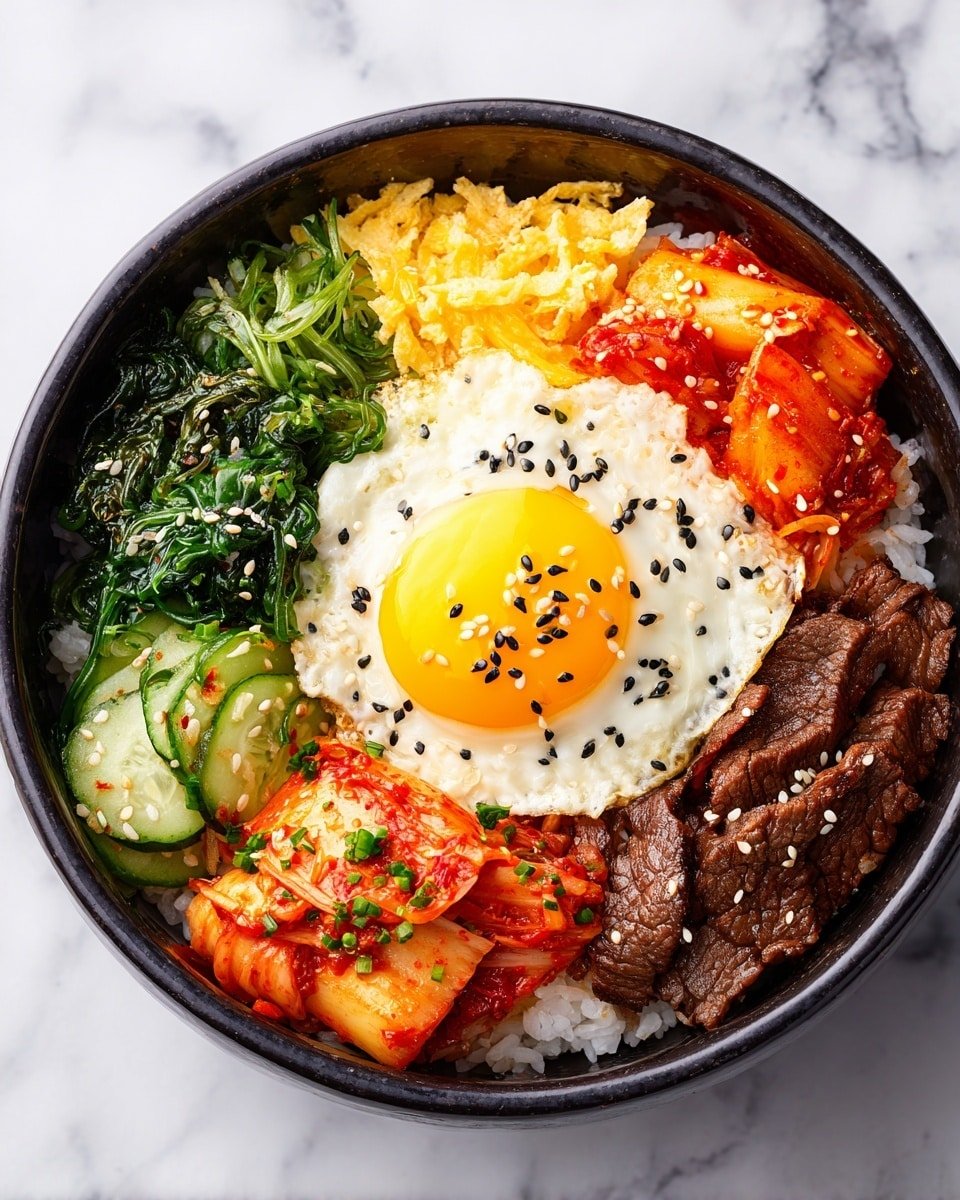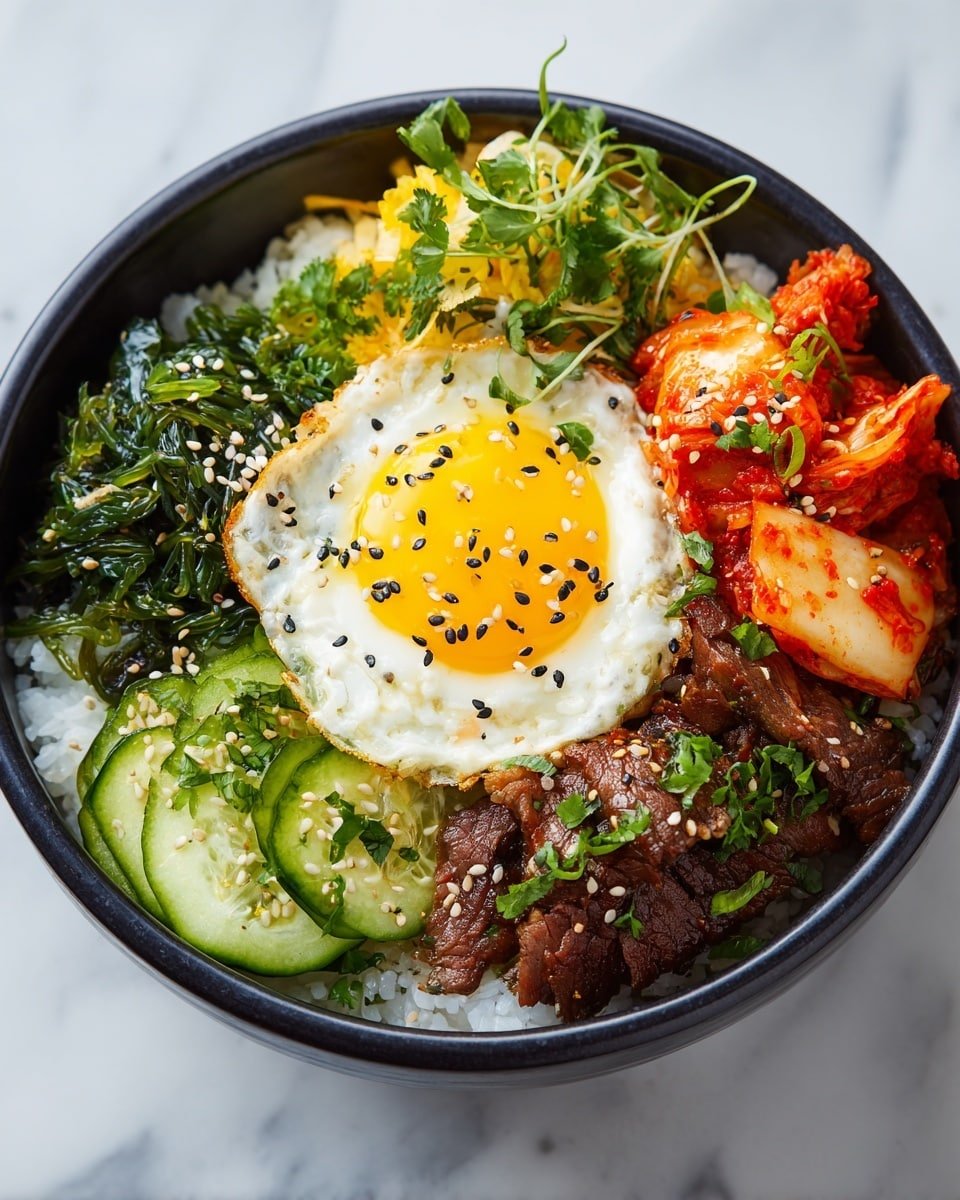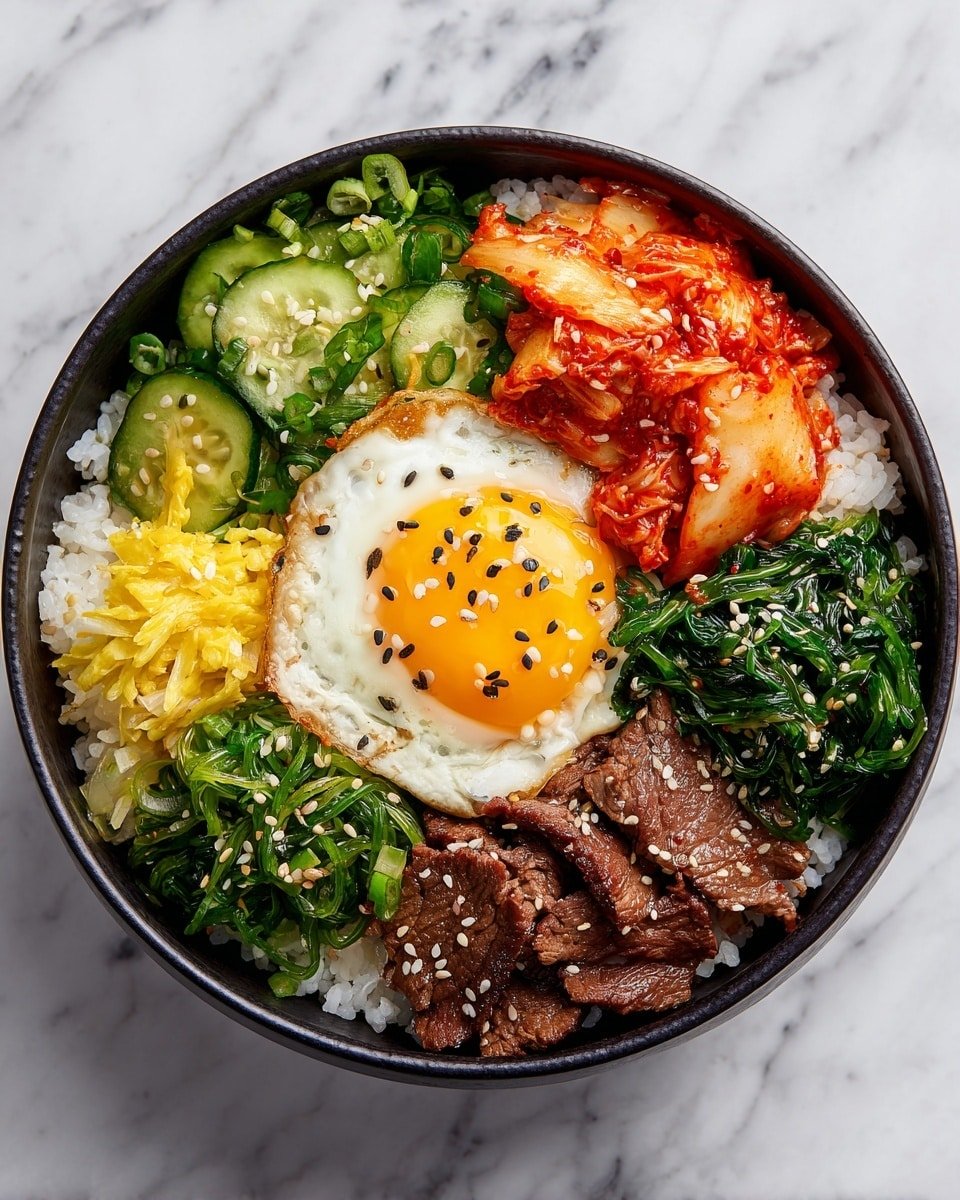The Easy Korean Beef Bibimbap Recipe That Bursts With Flavor Recipe is a vibrant and satisfying dish perfect for busy weeknights or anytime you want a comforting meal with a Korean twist. Packed with savory marinated beef, crisp sautéed veggies, and a perfectly runny egg, this recipe is approachable yet impressively flavorful. I love how every bite combines textures and tastes that keep you coming back for more.

Jump to:
What Sets This Apart
This bibimbap recipe strikes the perfect balance between authenticity and simplicity, making it easy for home cooks to whip up a dish full of rich Korean flavors without fuss or intimidating techniques.
- Consistent Results: A straightforward marinade ensures your beef stays juicy and tender every time.
- Rich, Balanced Flavor: Sweet, savory, nutty, and spicy notes blend harmoniously for depth that excites the palate.
- Pantry-First Ingredients: Uses accessible ingredients like ground beef, soy sauce, and gochujang, which you can find in most stores.
- Weeknight Friendly: Takes just about 30 minutes from start to finish, perfect for a hassle-free dinner.
Ingredient Snapshot

For this Easy Korean Beef Bibimbap Recipe That Bursts With Flavor Recipe, selecting fresh, quality ingredients really elevates each component from the beef to the veggies. Sourcing gochujang from your local Asian market or a reliable online shop is key to nailing those bold, spicy undertones.
- Ground beef: Choose lean beef for tenderness and to avoid excess grease during cooking.
- Soy sauce: Opt for a naturally brewed variety to add authentic umami depth.
- Brown sugar: Adds a slight sweetness that balances the savory elements perfectly.
- Fresh garlic: Minced finely to release that sharp, pungent aroma.
- Sesame oil: Use toasted sesame oil for that irresistible nutty flavor.
- Green onions: Brighten with fresh, finely chopped scallions.
- Carrots: Julienne or thinly slice for crunch and vibrant color.
- Zucchini: Light sauté brings out a tender yet firm texture.
- Spinach: Blanched briefly to retain its fresh, earthy green essence.
- Bean sprouts: Cooked just enough to keep a crisp snap.
- Gochujang: The spicy-sweet heartbeat of this bibimbap-don't skip it!
- Eggs: Sunny-side-up to give a glossy, creamy yolk finish.
- Steamed rice: Short-grain, sticky rice is essential as the warm, comforting base.
Quick Note: Exact measurements are in the printable recipe card at the bottom.
How to Make Easy Korean Beef Bibimbap Recipe That Bursts With Flavor Recipe
Step 1 - Prep & Season
Start by combining the ground beef with soy sauce, brown sugar, minced garlic, sesame oil, and green onions in a bowl. Mix gently but thoroughly to coat every bit of beef. Letting it sit for about 10 minutes really helps the flavors meld deeply. You'll notice the marinade becoming glossy and fragrant, which means you're off to a great start.
Step 2 - Build Flavor
Heat a skillet over medium-high and add your marinated beef. Cook it while stirring occasionally for about 5 to 7 minutes until browned and just a little crispy at the edges-this adds fantastic texture. In the meantime, lightly sauté the julienned carrots and zucchini in a touch of sesame oil until tender-crisp; this keeps vibrant color and crunch alive. Blanch spinach briefly in boiling water for 30 seconds, then squeeze out excess moisture. Finally, give bean sprouts a quick toss in a hot pan just until edges wilt slightly but remain crisp; these thoughtful steps layer textures beautifully.
Step 3 - Finish for Best Texture
Shift to low heat and carefully cook sunny-side-up eggs in a nonstick pan greased lightly. Watch closely until whites set while leaving yolks runny-about 3 minutes. Overcooking here loses the luscious sauce effect the yolk brings. To assemble, spoon warm steamed rice into bowls, arrange the cooked beef and veggies around the edges in sections, then place the egg right in the center. Don't forget a generous dollop of gochujang and a sprinkle of toasted sesame seeds. Immediately serve to enjoy the contrast of textures and flavors at their best.
Cook's Notes & Tricks
When I first made this Easy Korean Beef Bibimbap Recipe That Bursts With Flavor Recipe, I quickly learned that the secret lies in timing and texture balance. The beef shouldn't dry out, and the veggies must keep their crispness to contrast the warm rice and egg. Here's what to keep in mind:
- Doneness Cue: Cook the beef until just browned with lightly crispy edges, avoiding overcooking to keep it juicy.
- Temperature Trick: Use medium-high heat for rapid browning, then reduce heat when cooking eggs for perfect runny yolks.
- Make-Ahead Move: You can prepare veggies and marinate beef a few hours ahead; just store separately to maintain freshness.
- Avoid This Pitfall: Don't skip blanching spinach or quick sautéing bean sprouts-raw veggies will alter the dish's texture and taste.
Serve & Enjoy

Finishing Touches
For the finishing touches, dollop the gochujang generously so it delivers a spicy-sweet punch right at the first bite. The toasted sesame seeds add that last lovely crunch and nuttiness. When you break into your sunny-side-up egg, the golden yolk melts over everything, creating a luxurious sauce that ties all flavors together beautifully.
Pairs Beautifully With
I love pairing this bibimbap with simple, crisp sides like kimchi or a light cucumber salad to add cooling contrast. A cup of warm green tea or a chilled lightly sweetened barley tea complements the bold flavors perfectly, refreshing your palate between bites.
Simple Plating Wins
To plate beautifully on a casual weeknight, keep veggies arranged in neat segments around the rice for eye appeal and ease of mixing. For special occasions, try serving in individual stone or ceramic bowls to hold heat longer and provide that authentic restaurant vibe. A sprinkle of sliced green onions or extra sesame seeds on top adds a pop of color and texture that's utterly inviting.
Make-Ahead, Storage & Reheat
Storing Leftovers
Use airtight containers to store leftover bibimbap components separately if possible, keeping beef and veggies from softening too much. Stored this way in the fridge, they'll stay good for up to 3 days. Expect the rice texture to firm up slightly but still taste great once reheated.
Freezing Tips
This dish freezes decently without the egg-freeze beef and vegetables in portioned containers. Thaw overnight in the fridge for best quality and reheat gently. The rice may become a bit drier, so add a splash of water when warming to maintain moisture.
Reheating Easy Korean Beef Bibimbap Recipe That Bursts With Flavor Recipe Without Drying Out
Reheat in the microwave on medium power with a damp paper towel covering the container to keep moisture in, warming in 30-second intervals to prevent drying. Alternatively, use an oven set to 300°F (150°C) covered loosely with foil for 10-12 minutes. An air fryer can crisp veggies nicely again at 320°F for about 5 minutes. Reheat eggs fresh if possible, as they don't warm well.
Frequently Asked Questions
Absolutely! Ground chicken or turkey work well, and thinly sliced beef or tofu can be delicious alternatives, just adjust cooking times accordingly.
The heat mainly comes from gochujang, which offers mild to moderate spice with a sweet undertone. You can adjust the amount based on your heat preference.
Yes, mixing all components before eating allows the flavors and textures to meld beautifully, giving you the classic bibimbap experience.
Definitely. You can marinate and cook the beef and veggies in advance, then quickly reheat and assemble when ready to eat.
Final Thoughts
This Easy Korean Beef Bibimbap Recipe That Bursts With Flavor Recipe is one of my favorite dinners to pull together when I want something nourishing, bold, and quick. The layering of textures and flavors creates a satisfying bowl that's both comforting and exciting. You'll find it perfect for introducing Korean cuisine at home or just enjoying a wholesome, colorful meal on any night. Give this recipe a go - once you taste it, you'll know why I keep coming back for more.
PrintFull Recipe
Easy Korean Beef Bibimbap Recipe That Bursts With Flavor Recipe
This easy Korean Beef Bibimbap recipe bursts with authentic flavors and vibrant colors. Featuring marinated ground beef, sautéed vegetables, and a spicy-sweet gochujang sauce, it's a delightful and satisfying meal topped with a runny fried egg and toasted sesame seeds.
- Prep Time: 10 minutes
- Cook Time: 20 minutes
- Total Time: 30 minutes
- Yield: 4 servings
- Category: Main Course
- Method: Stovetop
- Cuisine: Korean
- Diet: Low Lactose
Ingredients
For the Marinated Beef
- 1 pound ground beef (lean)
- 3 tablespoons soy sauce
- 1 tablespoon brown sugar
- 2 cloves garlic, minced
- 2 teaspoons toasted sesame oil
- 2 stalks green onions, finely chopped
For the Vegetables
- 1 cup carrots, julienned or thinly sliced
- 1 cup zucchini, sliced
- 2 cups spinach, blanched and squeezed dry
- 1 cup bean sprouts, briefly cooked
For the Sauce and Toppings
- 4 tablespoons gochujang (Korean chili paste)
- 4 large eggs
- 1 tablespoon toasted sesame seeds
For Serving
- 4 cups steamed short-grain sticky rice
Instructions
- Marinate the beef: In a bowl, combine ground beef with soy sauce, brown sugar, minced garlic, sesame oil, and green onions. Let sit for 10 minutes to allow the flavors to infuse deeply.
- Cook the beef: Warm a skillet over medium-high heat. Add the marinated beef and cook, stirring occasionally, for 7 minutes until browned and slightly crispy, sealing in the rich juices.
- Sauté carrots: Heat a drizzle of sesame oil in a pan over medium heat. Add julienned carrots and stir for 3 minutes until tender-crisp and bright orange.
- Sauté zucchini: In the same pan, add sliced zucchini and cook for 2 minutes, stirring gently until edges are lightly golden but zucchini remains firm.
- Prepare spinach: Bring a pot of water to a rapid boil. Add spinach leaves for 30 seconds, then drain and gently squeeze out excess water.
- Sauté bean sprouts: Quickly sauté bean sprouts in a hot skillet for 2 minutes until crisp with slightly wilted edges.
- Fry the eggs: Heat a nonstick pan over low heat with a touch of oil. Crack eggs in and cook for about 3 minutes until the whites are set but yolks remain runny.
- Assemble the bibimbap bowls: Divide warm steamed rice among four bowls. Arrange cooked beef and sautéed vegetables in sections around the edges, leaving center space for the egg. Top each bowl with a sunny-side-up egg, a dollop of gochujang sauce, and a sprinkle of toasted sesame seeds. Serve immediately.
Notes
- Use lean ground beef for tenderness and healthier eating.
- Adjust gochujang to your preferred spice level.
- Make sure to squeeze excess water from spinach to prevent sogginess.
- Cook eggs gently over low heat to keep yolks runny for added creaminess.
- For extra flavor, you may add a drizzle of sesame oil when assembling the bowl.







Leave a Reply